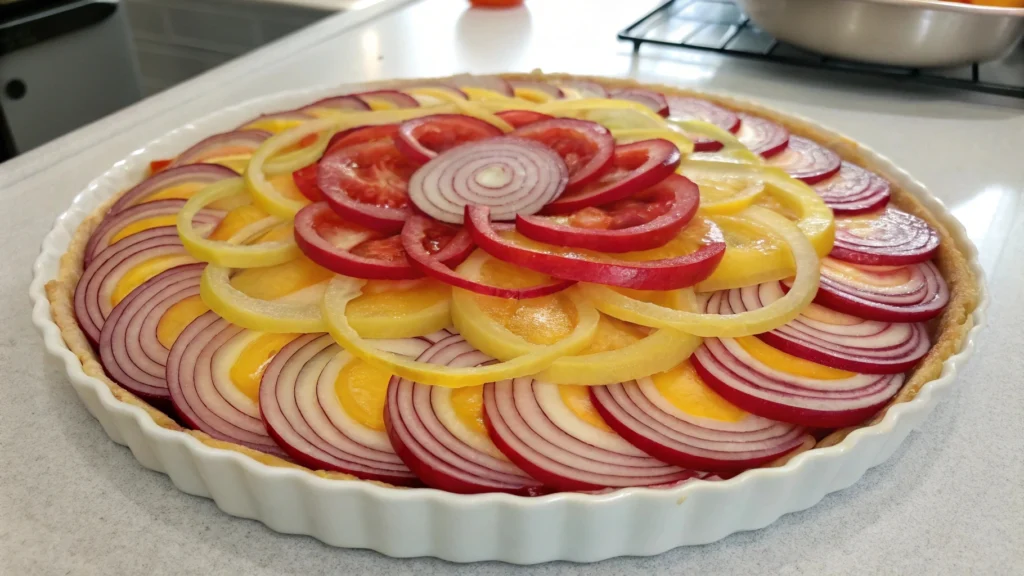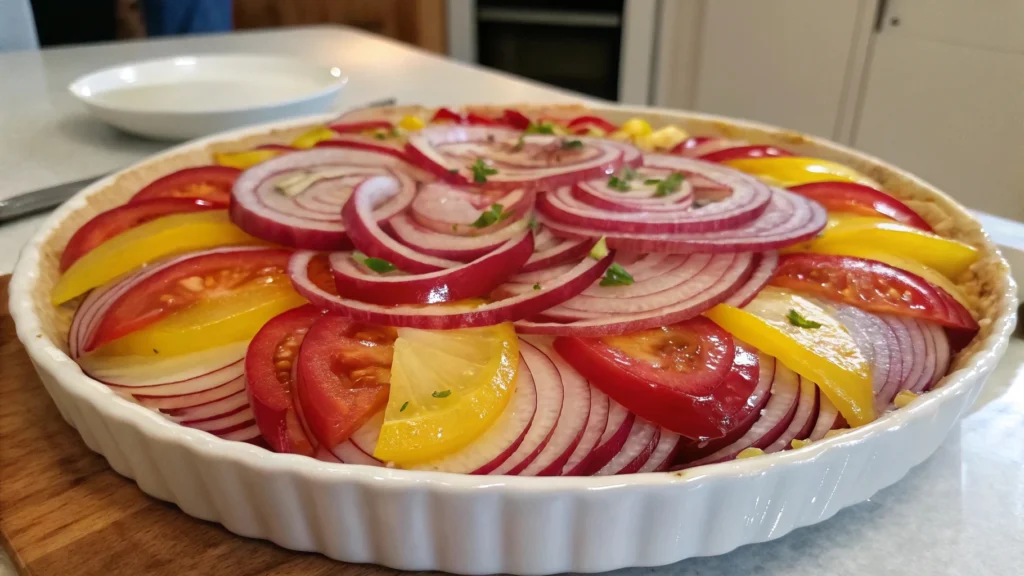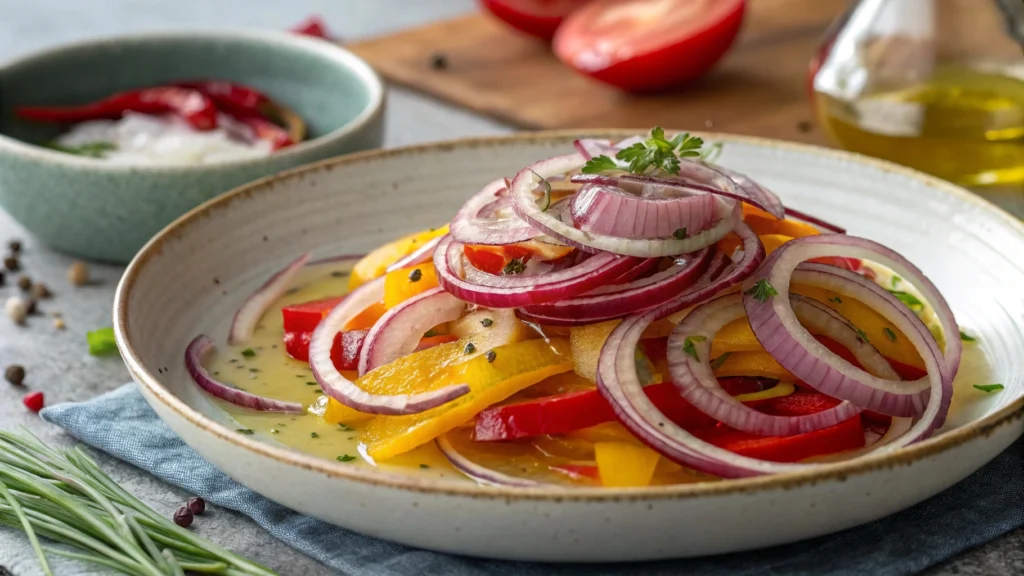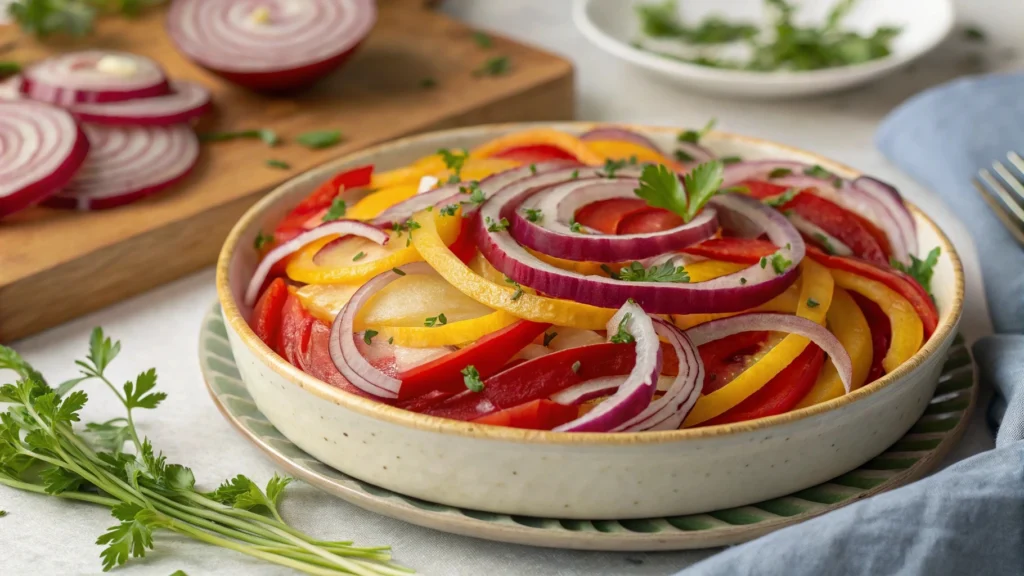Introduction: Why Onions Deserve a Spot in Your Daily Cooking

You’ve probably peeled and chopped more onions than you can count—but have you ever paused to appreciate their role in your cooking? Whether it’s the comforting aroma that fills your kitchen as they sauté in olive oil, or the bold bite of raw onion on a fresh salad, onions shape flavor like no other ingredient.
From simple weeknight dinners to elaborate holiday feasts, onions are the foundation of countless recipes across cultures. Not only are they versatile and affordable, but they also come packed with nutritional benefits—from antioxidants to gut-friendly fiber.
In this article, you’ll discover 10 brilliant, practical ways to make onions a flavorful, functional hero in your everyday meals. Onion recipes.
Understanding Different Types of Onions and Their Uses
Common Onion Varieties You Should Know
- Yellow onions: Your all-purpose option, ideal for stews, soups, and sautés.
- Red onions: Mild and crisp, perfect raw in salads or grilled.
- White onions: Sharper and spicier; great for Mexican or Latin dishes.
When to Choose Sweet Onions
- Vidalia, Walla Walla, and Maui onions are naturally sweet and ideal for roasting or caramelizing.
- Use in dishes where you want subtle onion flavor without pungency.
Specialty Onions for Culinary Depth
- Shallots: Delicate and slightly garlicky; excellent in vinaigrettes and sauces.
- Cipollini: Small and sweet, perfect for roasting whole.
- Pearl onions: Best for pickling or as a stew garnish.
Data Point: According to the National Onion Association, yellow onions make up 87% of U.S. onion production—showing their dominance in daily cooking.
Classic Cooking Techniques That Bring Out the Best in Onions
Mastering the Sauté
- Use a stainless steel or cast iron pan.
- Sauté over medium heat until translucent to build flavor in soups or stir-fries.
Caramelizing Onions Like a Pro
- Cook low and slow (about 40–45 minutes).
- Add a pinch of salt and a bit of sugar to accelerate caramelization.
- Deglaze with wine or broth for added depth.
Roasting Onions for Natural Sweetness
- Slice thick and roast at 400°F for 25–30 minutes.
- Ideal as a side dish or sandwich topper.
Grilling for Smoky Flavor
- Thick rounds or wedges brushed with oil.
- Great on burgers, kebabs, and tacos.

Creative Everyday Recipes That Showcase Onions
Fresh and Raw Applications
- Add thin red onion slices to Greek salads.
- Mix chopped onions into fresh tomato salsa.
Sandwiches and Wraps
- Grilled onions in paninis and burgers.
- Pickled onions to add zing to tacos or falafel wraps.
Sauces, Soups, and Casseroles
- French onion soup with deeply caramelized onions.
- Creamy onion dip for snacking.
- Onion-enhanced marinara or curry bases.
Breakfasts with a Flavor Kick
- Onion and spinach frittata.
- Caramelized onion and goat cheese omelet.
Recipe Table: Onion & Spinach Frittata
| Ingredient | Quantity |
|---|---|
| Eggs | 6 large |
| Yellow onion (sliced) | 1 medium |
| Fresh spinach | 1 cup |
| Olive oil | 2 tbsp |
| Salt and pepper | To taste |
Onions as the Unsung Flavor Foundation
Building Blocks of Flavor
- Mirepoix (onion, carrot, celery): French base for soups and sauces.
- Soffritto (onion, garlic, carrot): Italian aromatic blend.
Stocks, Broths, and Beyond
- Use onion skins and trimmings for vegetable stock.
- Adds umami and depth to chicken or beef broth.
Homemade Sauces and Gravies
- Onion-based béchamel or curry gravies.
- Onion gravy for mashed potatoes or meat dishes.
The Maillard Reaction in Onions
- How browning onions boosts flavor through amino acids and sugars.
- Use butter or oil and avoid overcrowding the pan.

Nutritional Benefits and Storage Tips: Onion recipes
Health Benefits of Onions
- Rich in sulfur compounds, quercetin, and antioxidants.
- Supports heart health, immunity, and digestion.
Storing Onions the Right Way
- Keep in a cool, dry place—not the fridge.
- Store away from potatoes to prevent sprouting.
No More Tears
- Chill onions before cutting.
- Use a sharp knife and ventilate your space.
Onions in a Healthy Diet
- Adds low-calorie, high-flavor content.
- Encourages plant-based eating habits.

FAQs: Onion recipes
What is the best onion for everyday cooking?
Answer: Yellow ones are the most versatile—they work well in most cooked dishes due to their balance of sweetness and pungency.
Are onions healthy to eat daily?
Answer: Yes. They are rich in antioxidants and sulfur compounds that support heart health, reduce inflammation, and improve gut health.
Can I freeze chopped onions for later use?
Answer: Absolutely. Chop and store in an airtight container or freezer bag for up to 3 months. Great for soups and stews.
What’s the difference between sautéed and caramelized onions?
Answer: Sautéed onions are cooked quickly until soft and translucent. Caramelized onions are cooked slowly until deep brown and sweet.
Conclusion – Bring Onion recipes to the Center of Your Kitchen
Onions are far more than a background flavor—they’re the soul of the dish. By understanding different types, mastering essential techniques, and using them creatively in meals, you’ll unlock a new level of cooking satisfaction.
So the next time you slice an onion, remember you’re not just prepping an ingredient—you’re building something delicious from the ground up.
